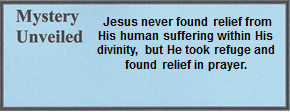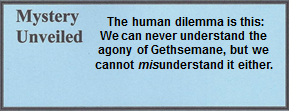15.02.03 Mk. 14:35-36; Lk. 22:43-45; Mt. 26:40-41 Mount of Olives
JESUS PRAYS IN AGONY AS THE DISCIPLES SLEEP
Mk. 35 Then He went a little farther, fell to the ground, and began to pray that if it were possible, the hour might pass from Him. 36 And He said, “Abba, Father! All things are possible for You. Take this cup away from Me. Nevertheless, not what I will, but what You will.”
Lk. [43 Then an angel from heaven appeared to Him, strengthening Him. 44 Being in anguish, He prayed more fervently, and His sweat became like drops of blood falling to the ground.] 45 When He got up from prayer and came to the disciples, He found them sleeping, exhausted from their grief.
Mt. 40 Then He came to the disciples and found them sleeping. He asked Peter, “So, couldn’t you stay awake with Me one hour? 41 Stay awake and pray, so that you won’t enter into temptation. The spirit is willing, but the flesh is weak.”
In this first of three prayers, Jesus simply unburdened His heart to His Father. He understood what He was about to face, but the disciples seemed to be failing continuously. It is not only significant that Jesus prayed three times, but also that it was recorded three times. When a word, phrase, or event is recorded three times, it is a Hebraic method of underlining its maximum significance.
“Abba, Father.” This Aramaic word for father is equivalent to the English word daddy. It is reflective of an affectionate loving relationship.[1] With this use (cf. Gal. 4:6; Rom. 8:15) believers can come to the Father God and call Him “Daddy.” This is the name used by a child for his earthly father. There is no evidence in rabbinic writings that the Jews ever addressed God with this term of endearment – it was a new revelation for the disciples.[2]
“This cup.” Jesus understood the price He would have to pay for those whom He loved. It is difficult to understand the enormous courage it took for Jesus to walk toward His death, not to mention the incredible suffering and shame He endured. He clearly understood what was before Him, which underscores the significance of His courage. There are two significant elements to the cup:
- The cup represents all the pain, bitterness, and sins of humanity for which He would be the sacrificial lamb, and therefore die in the place of those who place their faith and trust in Him.
- The cup represents the wrath of God upon sin, so it would be upon Jesus and not on those who faithfully obey and trust Him.
There are also two incorrect interpretations of the cup.
- Some have said that Jesus ment His physical death, but that is disproved in John 10:17; Luke 19:10 Philippians 2:8 and Hebrews 10:5-9.
- Other scholars have said the cup referred to His premature death, but that is disproved in Luke 22:46 and John 10:18.
Jesus wanted both the hour (Mk. 14:35) and the cup (Mk. 14:36) to pass. For a fleeting moment He wanted to escape the agony of the cross, but this thought evaporated, for it could not be avoided. The Father’s will had to be completed and Jesus was faithful to accomplish it. The temptation here was greater than anything He had ever experienced. Some scholars believe the cup is an allusion to the third cup of the Passover, which was a cup of redemption, salvation, life, and covenant. Others say the cup is symbolic of the divine wrath that Jesus would bear for the sins of others.[3] The phrase also reflects Satan’s temptation to prevent Jesus from fulfilling His mission.

“Being in anguish.” The aorist participle suggests that this agony was one growing in intensity.[4] This was common for those dying on a cross. Luke used the word “agony” in 22:44, meaning conflict.[5]
“His sweat became like drops of blood falling to the ground.” This rare phenomenon occurs when someone is under extreme stress and blood capillaries in the sweat ducts burst. Blood is then mixed with the perspiration and is known in modern Greek medical term as hematidrosis.[6] The heavy fluid loss coupled with the lack of sleep, the emotional and physical fatigue, began the dehydration process that would culminate with His death on the cross.[7]
Nineteenth century critics have long said this would be impossible, yet human history records such rare events. Church history records that this medical condition occurred again in the sixteenth century when the French king sentenced two men to their deaths. Saint Bartholomew and the other person, both of whom were accused of being a thieves, sweated drops of blood before being executed by the papal court of justice.[8]
As the Son of God, Satan could not touch Him. But as the Son of Man, Jesus was in a fierce battle and this was to be Satan’s last onslaught against Him. Jesus did not fear death on the cross; He feared that He might not succeed as the Son of Man. While He understood that His sacrifice would be for all the sins of humanity, He also understood that He was capable of failing.

“He found them asleep” Jesus did not find just one or two of His disciples asleep, but all of them. This was a huge failure on their part, even if they were exhausted. The code of conduct between a disciple and his rabbi was that the disciple cared for and protected his rabbi. A rabbi was considered to be closer than one’s father. All twelve failed miserably at a very basic code of conduct, for which there is no parallel in today’s Western culture. They had been told several times of the events that were about to unfold, yet they failed to understand. Now, when Jesus needed them most, they failed and He was all alone. They were nearby physically, but distant emotionally and spiritually.
[1]. Neusner and Green, eds., Dictionary of Judaism. 2.
[2]. Martin, Worship in the Early Church. 35; Barclay, “Matthew.” 2:349.
[3]. See also references in Ps. 11:6; 75:8; Is. 51:17, 22; Jer. 49:12; Rev. 14:10; 16:19; 17:4.
[4]. Vincent, Word Studies in the New Testament. 1:425.
[5]. Fruchtenbaum, The Jewish Foundation of the Life of Messiah: Instructor’s Manual. Class 23, page 16.
[6]. Edwards, Gabel, and Hosmer. ”On the Physical Death of Jesus Christ.” 1456; Fruchtenbaum, The Jewish Foundation of the Life of Messiah: Instructor’s Manual. Class 23, page 16. Lang, Know the Words of Jesus. 364.
[7]. Dauer, How Jesus Died: The Final 18 Hours. (Video).
[8]. Major, Manson, and Wright, The Mission and Message of Jesus. 288.